Sign up for Lesson Plans, discounts & more!
The Cretaceous Period:
Flowers Bloom For The First Time
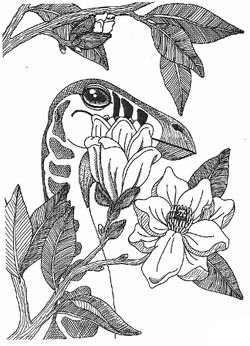
The Cretaceous Period was the heyday for Dinosaurs! It was also the time of the break up of Pangea. This was a major change that included the opening of the Atlantic Ocean with its volcanic center, the Mid Atlantic Rift, a chain of volcanic mountains thousands of miles long. Oh, and don't forget the flowering plants, and the insects that developed because of them.
This is the final period of the Mesozoic Era.
It covered the time span of 144 million years ago to 65 million years
ago. There was a minor mass extinction at the end of the Jurassic Period
that is the sign of the beginning of the Cretaceous. Many of the
species of bivalved mollusks (similar to clams) became extinct at this
time.
The Continents During The Cretaceous
The changes to the continents continued in the Cretaceous Period. Laurasia and Gondwana continued to move apart. On the eastern side of Laurasia, the North Atlantic Ocean was formed. It covered the east coast of North America and most of western Europe.
The Break up of Gondwana
In Gondwana, South America and Africa broke apart. The ocean floor was spreading along a crack in the earth’s crust called a rift. This eventually led to the South Atlantic Ocean. Another rift on the eastern side of Africa caused a waterway between Africa and a body of land that contained modern Madagascar and India.
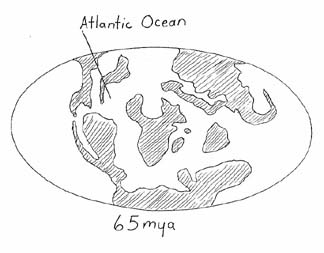
Rising Sea Levels
The rift between Africa and South America created a long chain of volcanic mountains underwater. These mountains grew as the Atlantic Ocean got wider. As these mountains grew they displaced a tremendous amount of water. So much in fact that the water level of the seas was about 100 meters higher than today. This caused many inland seas to form. In North America, an inland sea divided the continent across the plains of modern-day Canada and the United States all the way to the Arctic Ocean.
New Dinosaurs
Animal life continued to develop much as it had in the Jurassic. New species of dinosaurs became important. The ceratopsian dinosaurs appeared for the first time. These were plant-eating ornithischian, or bird-hipped, dinosaurs. The most famous example is the triceratops. It had three horns and a huge, bony frill that formed its skull.
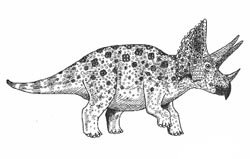
Enter The King
The most famous dinosaur of all, the Tyrannosaurus rex, finally came along during the end of the Mesozoic Era. Tyrannosaurus rex was a reptile-hipped dinosaur. It walked on two legs so is a theropod. All theropods were carnivorous.
The Seas of The Cretaceous Period
Sea life was not very different in the Cretaceous Period than in the Jurassic Period. There was neither a major extinction nor a huge burst of new species. There were many fish, mollusks, and arthropods to feed the giant sea reptiles that still lived in the Cretaceous Oceans.
Nature Invents The Flower!
The most important development of the Cretaceous Period was the growth of flowering plants. Before this, most of the trees had been gymnosperms or plants with cones. Now trees began to produce flowers. The ancestors of many modern tree species appeared during the Cretaceous including the magnolia and the maple.
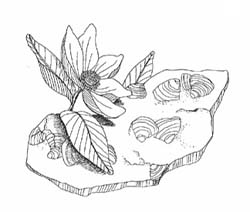
Flowers Are A Boon To The Insects
With flowers came many
insects including butterflies, ants, termites and bees. While the
flowering plants provided food for these insects, the insects made sure
the pollen spread from flower to flower to produce the seeds that would
keep the flowers reproducing.
Mammals Bide Their Time
Mammals continued of course, but they were not very important. These were tiny creatures compared with the giant dinosaurs. The new placental mammals were an important evolution in mammal species. These mammals developed their offspring inside their bodies. The infant mammal was fed through an organ called the placenta.
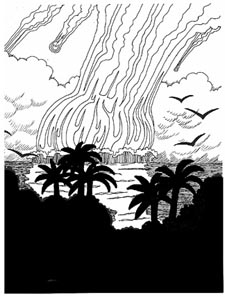
The KT Event- The End of The Cretaceous Period
There seems to have been a major event that caused the mass extinction at the end of the Cretaceous Period. It is called the KT event for (K)Cretaceous and (T) Tertiary, the first period of the Cenozoic Era which follows. A popular theory is that a meteor hit the earth in the Gulf of Mexico off the Yucatan Peninsula. This caused many geologic activities. Volcanoes erupted. Clouds, smoke and dust covered the skies keeping the sun’s light away from the planet for years. This would have caused huge changes in the climate and vegetation.
Major Extinctions
The
KT event caused the extinction of more than 70 % of the species that
lived in the oceans and 15% of the species on land. In fact, all land animal species over 50 pounds
seem to have become extinct. Nearly all dinosaurs became extinct at
this time. Modern birds, descendents of the dinosaurs, are all that
remain of the animals that had ruled the planet for so many millions of
years. In the seas, the ammonites and belemnites were wiped out along
with the large marine reptiles including the icthyosaurs, plesiosaurs,
and mosasaurs.
Dawning of The New Era
Even though so
much of the life of the Cretaceous Period had been hurt or eliminated,
the species that survived were ready for the hard work ahead. The
Cenozoic Era that follows is the time of the mammals. With the large
reptiles out of the way, these small land animals were able to develop
into many new and different species. It wouldn’t be long before it would
be the mammals that ruled the earth.
Return to Geologic Time Line
Before the Cretaceous Period is the Jurassic Period
The next period is The Tertiary Period
Check out some of the Educational Materials for sale on our sister site fossilicious.com.

interested in more? If so, you may want to check out our other sites:
fossilicious.com - Our online fossil and mineral rock shop.
rocksandminerals4u.com - An educational site about rocks, minerals, and geology.
Geologic Time Geologic Time Line
Cenozoic Era
Quaternary
Neogene
Paleogene
Mesozoic Era
Cretaceous
Jurassic
Triassic
Paleozoic Era
Permian
Carboniferous
Devonian
Silurian
Ordovician
Cambrian
Archean Time
Hadean Time
Teachers Resources
Activities for Education and Fun
Earth Science Lesson Plans
Activities For Kids
Fossil Lesson Plans
Fossil Activities
Education Articles
Coloring Pages
Dinosaur Coloring Pages
Montessori Materials
Geology Club
Fossil Hunting
 |
 |
 |




